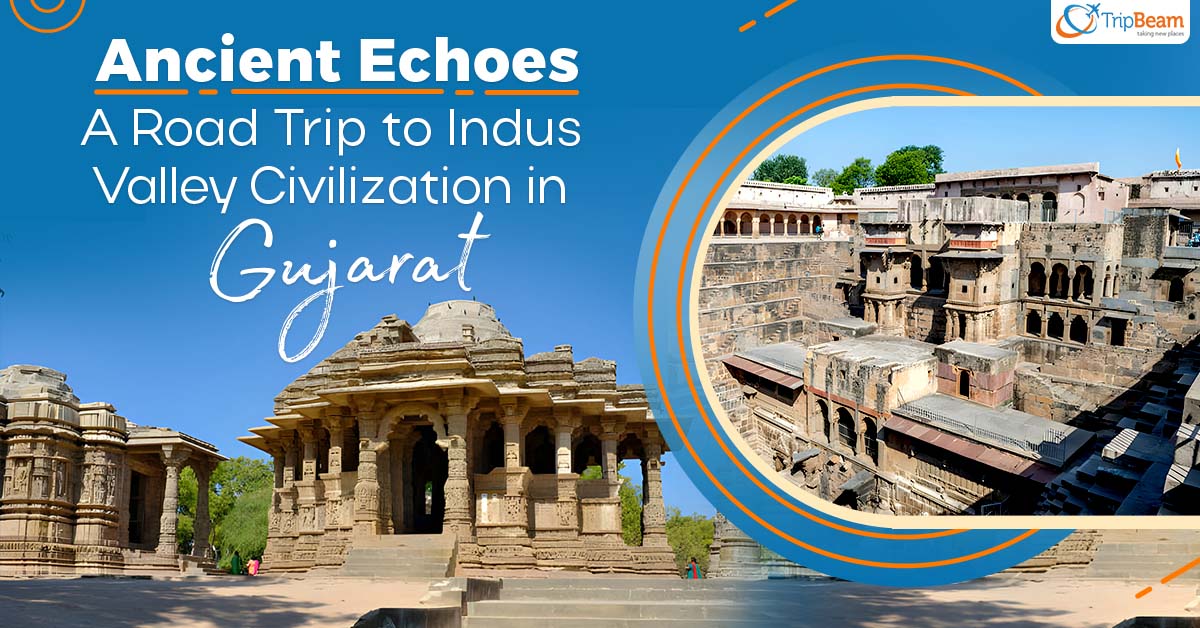

The Indus Valley civilization, a Bronze Age society in northwest South Asia, thrived in the Indus River basins. It’s amazing to discover that, despite what we’ve all learned about the Harappan society, picturing its magnificence need not only be a fantasy. Since the Harappan culture is a ray of our old and rich past, we Indians have the rare opportunity to explore the ruins of the Indus Valley Civilization. Living in tandem with the great civilizations of Mesopotamia and Egypt, this civilization—one of the first urban societies in history—grew from 2500 to 1700 BCE. Thus, in this article, we are taking you on a road trip to the Indus Valley Civilization in Gujarat. Additionally, you can visit Tripbeam to book cheap flights from Calgary to Mumbai.
More than 200 sites from this ancient period can be found in Gujarat, most of them concentrated around three important locations: Lothal, Surkotada, and Dholavira. In the past, this civilization was present in northeastern Afghanistan, Pakistan’s Balochistan, and western Uttar Pradesh. While other significant sites have been relocated to Pakistan and Afghanistan due to historical partitions, Gujarat in particular still retains much of the splendor of ancient culture. Now that you can reserve a taxi in Ahmedabad, it’s like an open book, ready to be read and examined. It provides a window into a time that many people have only read about in history books.
Driving through India’s Indus Valley Civilization is an adventure through historical landscapes and a window into a bygone past, where imagination and the ruins of a 6000-year-old civilization collide. It is only normal to have questions regarding the lifestyles, beliefs, and practices of the Harappan people when visiting these ancient monuments. What did they do for a living every day? Which social structures and beliefs ruled their society? These kinds of questions turn the trip into a captivating experience that transports you to their world.
Not only is it an exciting vacation, but it’s also an opportunity to experience a little of history and follow in the footsteps of a prehistoric community that had a big impact on current society: the Indus Valley civilization. You get to go across the exact regions that the Harappan people formerly called home. They are well known for their beautiful seal carvings, skilled metallurgy, and clever urban design. Witnessing and engaging with the wonders of a culture that has withstood the test of time provides a singular viewpoint on the development and history of human civilization.
If you are fascinated by history and ancient civilizations, the Indus Valley trail is a great choice for your next driving vacation. Start from Ahmedabad and follow the below-given directions. But first don’t forget to visit Tripbeam to book cheap tickets from Toronto to Ahmedabad.
The phrases Loth and thal (sthal) are thought to have been combined to create the word Lothal, which in Gujarati means “Mound of the Dead.” This unique civilization site was founded in 1954 and displays the Harappan culture in all of its forms. This site, the most easily accessible Harappan-era site in Western India, is located along the Bhogava River, a tributary of the Sabarmati. The city was mostly a port. The site stretches across seven hectares, making it eighteen times smaller than Mohenjodaro and estimated to be 3,700 years old. It appears that Lothal’s sturdy outer walls were constructed to withstand regular tidal floods. The settlement attracted the Harappans due to its safe harbor and fertile hinterland.
The two primary zones that comprise the quadrangular defensive layout are the upper and lower towns. The southeast-facing citadel, also known as the upper town, features four-meter-tall mud-brick platforms. The citadel’s wide walkways, rows of bathing platforms, and sewers indicate careful planning. Additionally visible are a square platform and a sizable building that appears to be a warehouse. Each part of the lower town had access to civic amenities, which divided it into two sections. The residential areas were to the east and west of the market.
The Surkotada site was discovered in 1964. There is a belief that a river once passed along the northeastern side and empties into the Little Rann. When the Harappans arrived in Surkotada around 2300 BCE, they built a fortified citadel and a residential annex using mud brick, lumps of mud, and detritus. The homes had sewers and bathrooms. It was occupied for four centuries without interruptions or desertions. Despite its diminutive size, archaeologists rank Surkotada among the most significant sites in terms of planning, right up there with Kalibangan and Lothal.
Among the intriguing discoveries are copper artifacts, painted ceramics featuring the Indus script, and a classic Harappan seal. There has also been a discovery of terracotta toys, tanks, and beads, as well as a cache of copper bracelets and beads. Reports indicate that the Surkotada site holds horse remains from 2000 BCE, which researchers consider a significant find. Also, you can check out Tripbeam.com to grab the cheapest flights from USA to India.
Dholavira is one of the Indus Valley’s five most important sites. The others are Mohenjodaro, Harappa, and Gharo Bhiro in Pakistan, and Rakhigarhi in India. Situated on the Khadir island in Kutch, Dholavira exhibits signs of urban planning, just like other monuments from the Indus Valley Civilization. Archaeologists have divided the site, known locally as Kotada, into three portions: the citadel, middle town, and lower town. The north-south and east-west axes of the Harappan city are approximately 600 and 775 meters, respectively.
The fortress contains a great deal of open spaces, wells, roadway networks, built-up regions, and entrances. The Dholavira Signboard consists of ten symbols that are visible on the northern gate of Dholavira. Given the likelihood, this could be the oldest signboard in the world. The range of funerary structures found here also sheds light on the socioreligious beliefs of the people who lived in this civilization.
Therefore, in addition to a voyage back in time, a trip through the historical landmarks of the Indus Valley civilization offers amazing photo opportunities and life-changing experiences. For a smooth and hassle-free travel experience, you can visit Tripbeam and book cheap flights from Toronto to New Delhi.
Also Read: Must Take Road Trips in India for Your Travel Zeal
Tell us more details to help better





